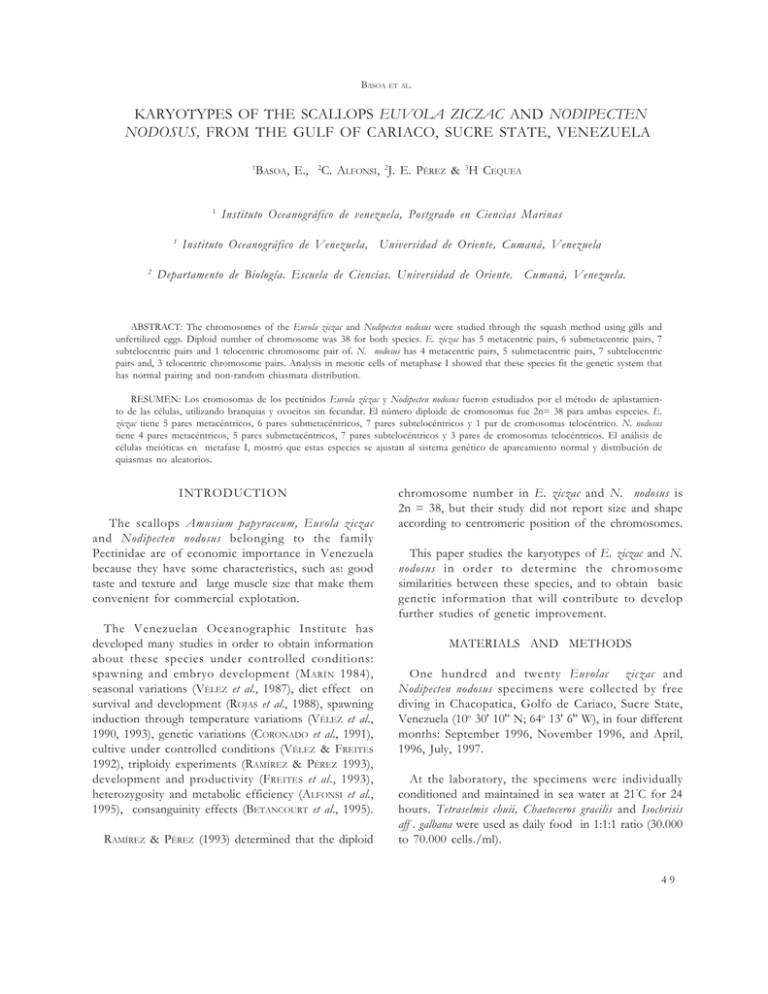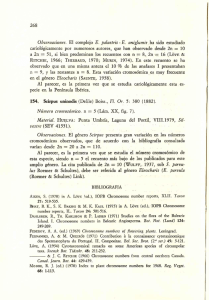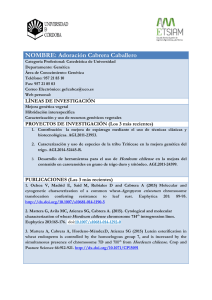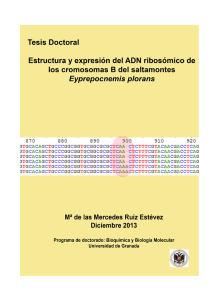karyotypes of the scallops euvola ziczac and nodipecten nodosus
Anuncio

BASOA ET AL. KARYOTYPES OF THE SCALLOPS EUVOLA ZICZAC AND NODIPECTEN NODOSUS, FROM THE GULF OF CARIACO, SUCRE STATE, VENEZUELA BASOA, E., 1 1 1 2 2 C. ALFONSI, 2J. E. PÉREZ & 3H CEQUEA Instituto Oceanográfico de venezuela, Postgrado en Ciencias Marinas Instituto Oceanográfico de Venezuela, Universidad de Oriente, Cumaná, Venezuela Departamento de Biología. Escuela de Ciencias. Universidad de Oriente. Cumaná, Venezuela. ABSTRACT: The chromosomes of the Euvola ziczac and Nodipecten nodosus were studied through the squash method using gills and unfertilized eggs. Diploid number of chromosome was 38 for both species. E. ziczac has 5 metacentric pairs, 6 submetacentric pairs, 7 subtelocentric pairs and 1 telocentric chromosome pair of. N. nodosus has 4 metacentric pairs, 5 submetacentric pairs, 7 subtelocentric pairs and, 3 telocentric chromosome pairs. Analysis in meiotic cells of metaphase I showed that these species fit the genetic system that has normal pairing and non-random chiasmata distribution. RESUMEN: Los cromosomas de los pectínidos Euvola ziczac y Nodipecten nodosus fueron estudiados por el método de aplastamiento de las células, utilizando branquias y ovocitos sin fecundar. El número diploide de cromosomas fue 2n= 38 para ambas especies. E. ziczac tiene 5 pares metacéntricos, 6 pares submetacéntricos, 7 pares subtelocéntricos y 1 par de cromosomas telocéntrico. N. nodosus tiene 4 pares metacéntricos, 5 pares submetacéntricos, 7 pares subtelocéntricos y 3 pares de cromosomas telocéntricos. El análisis de células meióticas en metafase I, mostró que estas especies se ajustan al sistema genético de apareamiento normal y distribución de quiasmas no aleatorios. INTRODUCTION The scallops Amusium papyraceum, Euvola ziczac and Nodipecten nodosus belonging to the family Pectinidae are of economic importance in Venezuela because they have some characteristics, such as: good taste and texture and large muscle size that make them convenient for commercial explotation. The Venezuelan Oceanographic Institute has developed many studies in order to obtain information about these species under controlled conditions: spawning and embryo development (M ARÍN 1984), seasonal variations (VÉLEZ et al., 1987), diet effect on survival and development (ROJAS et al., 1988), spawning induction through temperature variations (VÉLEZ et al., 1990, 1993), genetic variations (CORONADO et al., 1991), cultive under controlled conditions (VÉLEZ & FREITES 1992), triploidy experiments (RAMÍREZ & PÉREZ 1993), development and productivity (F REITES et al., 1993), heterozygosity and metabolic efficiency (ALFONSI et al., 1995), consanguinity effects (BETANCOURT et al., 1995). RAMÍREZ & PÉREZ (1993) determined that the diploid chromosome number in E. ziczac and N. nodosus is 2n = 38, but their study did not report size and shape according to centromeric position of the chromosomes. This paper studies the karyotypes of E. ziczac and N. nodosus in order to determine the chromosome similarities between these species, and to obtain basic genetic information that will contribute to develop further studies of genetic improvement. MATERIALS AND METHODS One hundred and twenty Euvolac ziczac and Nodipecten nodosus specimens were collected by free diving in Chacopatica, Golfo de Cariaco, Sucre State, Venezuela (10o 30' 10'’ N; 64o 13' 6'’ W), in four different months: September 1996, November 1996, and April, 1996, July, 1997. At the laboratory, the specimens were individually conditioned and maintained in sea water at 21ºC for 24 hours. Tetraselmis chuii, Chaetoceros gracilis and Isochrisis aff . galbana were used as daily food in 1:1:1 ratio (30.000 to 70.000 cells./ml). 49 Karyotypes of E. ziczac and N. nodosus The gill tissues were treated with 0.05% colchicine sea water for five hours, transferred to 0.9% sodiu citrate for 30 minutes and fixed in modified Carnoy solution (ethanol 95%: acetic acid, 3:1) for 20 minutes. This process was made twice and the tissues were stored in 50% acetic acid until used. The chromosomes of fixed cells were examined through the squash method and stained with 2% acetic orcein. Unfertilized eggs were used for meiotic analysis. The spawning of E. ziczac and N. nodosus adult specimens from natural populations was performed under controlled conditions, using the methods described by V ÉLEZ et al. (1990). When the spawning started, each specimen was isolated in plastic containers of 2 L, and unfertilized eggs were incubated with 0.2% colchicine solution in seawater during 2 h. After this, unfertilized eggs were exposed to 0,9% sodium citrate solution during 30 min, Carnoy solution and lipid solvent according to the methods described by ALFONSI et al. (1998). The best metaphase meiotic chromosome plates were photographed. according to JACKSON & HAUBER (1994). The symbols used throughout the text and their meanigs are the following: cII = a bivalent with one chiasma, oII = a bivalent with two chiasmata, C= mean chiasmata number per cell, x = a basic chromosome number. RESULTS AND DISCUSSION Diploid number of chromosomes was 38 for both species of scallops. The diploid number 2n=38 was counted in all cells at mitotic metaphase. The Euvola ziczac chromosome complement (Fig. 1 A,B) has 5 metacentric pairs (r = 1.0 - 1.7), 6 submetacentric pairs (r = 1.7 - 3.0), 7 subtelocentric pairs (r = 3.0 - 7.0) and 1 telocentric pair (r = 7.0 - ∞). The chromosome lengths Thirty eight E. ziczac specimens were used for analysis. From such analysis, forty eight gill metaphase cells, and one hundred and thirty five meiocytes were observed. From this sample, ten gill cells and seven meiocytes were chosen and analyzed. Forty two N. nodosus specimens, fifty two gill metaphase cells, and one hundred and thirty six meiocytes were observed. Twelve gill cells and nine meiocytes were selected from the latter sample and analyzed. The mitotic and meiotic metaphase chromosomes were studied under an Olympus light microscope BX 40 having a Sony Video camera connected and adapted to a computer. They were copied using a Photofinish software, and photographed with a Minolta camera X 300 S. Their images were transfered on the computer scrren. Ten mitotic methaphases in E. ziczac and twelve mitotic methaphase in N. nodosus were measured, ordered by pairs in decreasing order and analyzed statistically through a t-student test according to the method provided by LEVAN et al. (1964) . The metaphase I configurations for normal diploids were tested for normal pairing and non-random chiasmata distribution, using the equations: oII = C x, number of cells, and cII = x - (C - x), number of cells 50 Figure 1. Metaphase of somatic chromosomes from gill cell of Euvola ziczac A. Diploid karyotype of E. ziczac B. Chromosomes at metaphase of meiosis I from unfertilized eggs of E. ziczac C. BASOA ET AL. ranged from 2.17 ± 0.18 mm to 0.81 ± 0.08 mm (Table 1). Metaphase I configurations showed 5 circles and 14 bivalents chains (Fig. 1 C, Tabla 3). The mean chiasmata number per cell was 24. Table 1. Mean legths and arm ratios of chromosomes of ten metaphase plates in gill cells from Euvola ziczac. C h r o m o so m e M edi an St an dar d P ai r Len gt h (µm ) dev i at i o n Arm r at i o C h r o m o so m e t y p es 1 2.17 0.18 2.61 sm 2 1.78 0.08 3.06 st 3 1.47 0.09 3.01 st 4 1.45 0.03 2.67 sm 5 1.37 0.07 5.90 st 6 1.36 0.02 1.57 m 7 1.35 0.05 2.80 sm 8 1.34 0.10 4.19 st 9 1.32 0.03 3.27 st 10 1.28 0.12 1.54 m 11 1.18 0.15 2.04 sm 12 1.09 0.11 2.10 sm 13 1.06 0.18 1.59 m 14 0.95 0.20 1.26 m 15 0.92 0.17 1.50 m 16 0.91 0.14 1.73 sm 17 0.85 0.13 3.41 st 18 0.82 0.04 5.89 st 19 0.81 0.08 - t T o t al 23.48 Nodipecten nodosus chromosome complement (Fig. 2 A,B) corresponds to 4 metacentric pairs (r=1.0 - 1.7), 5 submetacentric pairs (r =1.7 - 3.0), 7 subtelocentric pairs (r = 3.0 - 7.0), and 3 telocentric pairs (r = 7.0 - ¥). Chromosome lengths ranged from 2.51 ± 0.14 mm to 0.84 ± 0.08 mm (Table 2). Metaphase I configurations showed 4 circles and 15 bivalents chains (Fig. 2 C, Tabla 3). The mean chiasmata number per cell was 23. The mitotic chromosomes from both species were homomorphic and isopycnotic, and different in sizes and shapes according to the centromeric position. No heteromorphic chromosome pairs were found to be responsible for sex determination. The absence of sex chromosomes in scallops has been reported by MENZEL (1968); AHMED (1973); MACKIE (1984) and VAN BRAND et al., (1990). Figure 2. Metaphase of somatic chromosomes from gill cell of Nodipecten nodosus A. Diploid Karyotype of N. nodosus B. Chromosomes at metaphase of meiosis I from unfertilized eggs of N. nodosus C. Significant differences were detected between the mean chromosomal length of boths scallops (ts = 2,0969; P< 0,05). The chromosome complements observed (2n= 38) in E. ziczac and N. nodosus, agreed with the number reported in other pectinidae species that include: Pecten maximus, Chlamys varia, Ch. distorta, Ch. islandica, Ch. farreri nipponensis, Ch. farreri, Placopecten magellanicus, Pecten albicans, P. jacobaeus, Patinopecten yessoensis, (B EAUMONT & G RUFFYD 1974; IEYAMA & VENUS 1975; RASOTTO et al., 1981; KOMARU 51 Karyotypes of E. ziczac and N. nodosus & W ADA 1985; Y ABU & M ARU 1987). However, Ch. opercularis has 2n = 26 and Argopecten irradians irradians, Ch. glabra, Ch. nobilis and A. purpuratus have 2n = 32 (B EAUMONT & G RUFFYD 1974; W ADA 1978; R ASOTTO et al., 1981; K OMARU & W ADA 1985; V AN BRAND et al., 1990). Table 2. Mean legths and arm ratios of chromosomes of twelve metaphase plates in gill cells from Nodipecten nodosus. C h r o m o so m e M edi an St an dar d P ai r Len gt h (µm ) dev i at i o n Arm r at i o C h r o m o so m e t y p es 1 2.51 0.14 - t 2 2.06 0.10 3.75 st 3 2.03 0.08 2.17 sm 4 1.78 0.09 - t 5 1.71 0.14 3.34 st 6 1.68 0.19 3.32 st 7 1.67 0.09 2.38 sm 8 1.67 0.14 3.32 st st 9 1.66 0.04 3.01 10 1.60 0.20 4.52 st 11 1.40 0.06 1.86 sm 12 1.29 0.11 1.98 sm 13 1.27 0.14 2.08 sm 14 1.26 0.15 1.28 m 15 1.24 0.13 3.58 st 16 1.05 0.17 1.26 m 17 0.98 0.12 1.19 m 18 0.87 0.09 1.36 m 19 0.84 0.08 - T o t al 28.57 Both studied scallop species had the same chromosome types and fitted a genetic system having a normal pairing and a normal non-random chiasmata distribution (Table 3). There is a minimum of one chiasma and a maximum of two chiasmata per bivalent, and the bivalents are essentially equal in crossover frequency. However, there are some chromosome differences, such as the following: a) cytological measurement indicating that N. nodosus chromosomes were larger than E. ziczac, b) E. ziczac has 5 metacentric and 6 submetacentric chromosome pairs while N. nodosus has 4 metacentric and 5 submetacentric chromosome pairs, c) E. ziczac has 1 telocentric 52 chromosome pair while N. nodosus has 3 telocentric chromosome pairs. These species are normally found in the same habitats and no variation in chromosome number and types was observed in all mitotic and meiotic cells analyzed, which may indicate that chromosome isolating barriers are very effective. Studies of the karyotypes in Pecten maximus, P. albicans, Chlamys farreri and Patinopecten yessoensis have indicated the presence of metacentric, submetacentric and telocentric chromosomes with a high number of telocentric chromosomes (BEAUMONT & GRUFFYD 1974; K OMARU & W ADA 1985). These chromosomes were larger than E. ziczac and N. nodosus chromosomes. Assuming that karyotypes in P. maximus, P. albicans, Patinopecten yessoensis, Argopecten irradians irradians, Ch. nobilis and A. purpuratus have been originated from an ancestral species with 2n = 38 chromosomes, the probable direction of evolution might have started from an ancestral form similar to P. maximus or P. albicans to P. yessoensis, E. ziczac and N. nodosus in one evolutionary line, where the telocentric chromosome centromeres have changed location through pericentric inversion or centric transposition resulting in metacentric or submetacentric chromosomes shorter than the ancestral species (WHITE 1973; AYALA & KIGER 1980). A second evolutionary line started from a form with 19 telocentric chromosome pairs, leading to A. irradians irradians, Ch. nobilis and A. purpuratus, where a Robertsonian centric fusion has taken place (AYALA & KIGER 1980; KOMARU & WADA 1985). Therefore, the modal number of 2n = 38 in the Pectinidae family has changed in some species during the evolution of the group. Chromosome evolution depends on pericentric inversions, centric transpositions or chromosome fusion /fission, but these events must involve the centromere. Table 3. Comparison of observed (Obs.) and expected (Exp) oII and cII at metaphase I in 7 cells of Euvola ziczac and 9 cells of Nodipecten nodosus o II cII Sp eci es O bs Ex p O bs Ex p X2 E. zi czac 35 35 89 98 0 N . n o do su s 36 36 135 135 0 BASOA CONCLUSIONS Euvola ziczac and Nodipecten nodosus have a chromosome complement of 2N=38. The E. ziczac chromosome lenghts ranged from 0,81µm to 2,17 µm and N. nodosus ranged from 0,84 µm to 2,51 µm. The chromosomes have normal pairing and non-random chiasmata distribution. Pericentric inversions and centric transpositions may have taken place during the E. ziczac and N. nodosus chromosome evolution. ET AL. IEYAMA, H. & J.VENUS. 1975. Chromosome number of the scallop Pecten albicans. J. of Malacol. 34 (12):26-32. J ACKSON , R.C. & H AUBER . A. 1994. Quantitative analyses of autoploid and alloploid taza in the Helianthus ciliaris group (Compositae). Amer J. Bot. 81(8):1063-1069. K OMARU , A. & K. W ADA . 1985. Karyotypes of four species in the pectinidae (Bivalvia: Pteriomorphia). Venus 44 (4): 249 - 259. REFERENCES A HMED , M. 1973. Cytogenetics of oysters. Cytology 38:337-346. L EVAN , A., K. F REDGA & A. S ANDBERG . 1964. Nomenclature for centromeric position on chromosomes. Hereditas 52:201-219. A LFONSI , C., O. N USSETTI & J.E. P ÉREZ . 1995. Heterozygosity and metabolic efficiency in the scallop Euvola ziczac (L.1758). J. Shellfish Res. 14 (2):389-393. M ARIN , B. 1984. Desove y desarrollo larval de Lyropecten nodosus en laboratorio. Trab. Grad. Lic. Biología, Universidad de Oriente, Cumaná, Venezuela, 54 pp. ALFONSI, C., E. BASOA & J. E. PÉREZ. 1998. Obtención de cromosomas de vieiras a partir de ovocitos. Act. Cient. Vzlna. 49(3):248-251 MACKIE, G. 1984. Bivalves. The Molluscan 7:351-418. AYALA, F. J., & J. A. KIGER. 1980. Modern genetics. The Benjamin/Cummings Publishing Company, Inc. Menlo Park, California, USA., 360 pp. B EAUMONT , A. & L. G RUFFYD . 1974. Studies on the chromosomes of the scallop Pecten maximus and related species. J. Mar. Biol. 54 (3):713-718. BETANCOURT, R., J. PÉREZ., A.VÉLEZ, L. FREITES, & M. SEGNINI. 1995. Efectos de la consanguinidad en la vieira Euvola ziczac (L). Bol. Inst. Oceanogr. Venezuela, Univ. Oriente. 34:69-75. CORONADO, C. P. GÓNZALEZ & J.E .PÉREZ. 1991. Genetic variation in Venezuelan molluscs: Pecten ziczac and Lyropecten nodosus (Pectinidae). Carib. J. Sci. 27 (1-2)71-74. FREITES, L., A. VÉLEZ & C. LODEIROS. 1993. Crecimiento y productividad de la vieira Pecten ziczac bajo varios sistemas de cultivos suspendidos. Ser Ocas. 2:259-269. MENZEL, R. 1968. Cytotaxonomy of the species of clams (Mercenaria) and oysters (Crassostrea). In: Proc. Symp. on mollusca, Part 1. Cochin, India: Mar Biol. Assoc. of India. 21:75-84. RAMÍREZ, A. & J. E. PÉREZ. 1993. Inducción de triploidía en la vieira Euvola ziczac. In: L. Mem. VI Simp. Lat. Acui. Bogotá, Colombia. 299pp. R ASSOTTO, M., D. A LTIERI & D. COLOMBERA. 1981. I Chromosomi spermatocitari di 16 species appartenenti alla clase pelecypoda. Soc. Malacol. Ital. 9:113-127. ROJAS, L., A.VÉLEZ & O. AZUAJE. 1988. Efecto individual y combinado de la densidad larval y la ración de alimento sobre la supervivencia y crecimiento de la vieira, Pecten ziczac. Bol. Inst. Oceanogr. Venezuela, Univ. Oriente. 27 (1-2):5762. VAN BRAND, E., G. BELLOLIO & K. LOHRMANN. 1990. Chromosome number of the Chilean scallop Argopecten purpuratus. Tohoku J. of Agricul. 40(3-4):91-95. 53 Karyotypes of E. ziczac and N. nodosus VÉLEZ, A., E. ALIFA & L. FREITES. 1990. Induction of spawning by temperature and serotonin in the hermaphroditic tropical scallop, Pecten ziczac. Aquaculture 84:309-312. 54 pectínidos Pecten ziczac y Lyropecten nodosus. Bol. Inst. Oceanogr. Venezuela, Univ. Oriente. 26 (12):67-72. , E. ALIFA & L. FREITES. 1993. Inducción de la reproducción en la vieira Euvola ziczac (Pecten) (Mollusca:Bivalvia) - Maduración y desove. Carib. J. Sci. 29 (3-4):209-213. WADA , K. 1978. Chromosome complement of three bivalves:The oysters, Isognomon alatus and Pinctada imbricata, and the bay scallop, Argopecten irradians irradians. Biol. Bull. 155:235245. . & FREITES, L. 1992. Cultivo de semillas de la vieira Pecten ziczac bajo condiciones controladas (Hatchery). Ser. Ocas. 2:311-317. YABU. H & K. MARU . 1987. Karyotypes of the specie the pectinidae Patinopecten yessoensis. Nipp. Suis. Gakkah. 53 (2):319-321. , F. S OTILLO & J.E.P ÉREZ . 1987. Variación estacional de la composición química de los WHITE , M. J. D. 1973. Animal Cytology and Evolution. 3rd Edition. Cambridge University Press. 961 pp.


